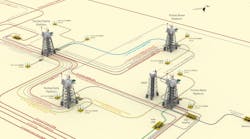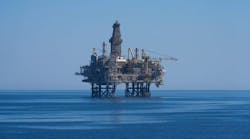NORTH AMERICA
Eni has delivered Mexico’s first major offshore oil discovery this year, in block 10 in the Sureste basin. The semisubmersible Valaris 8505 drilled the Saasken-1 NFW well in 340 m (1,116 ft) of water, encountering oil in the Lower Pliocene and Upper Miocene. Analysis indicates 200-300 MMbbl in place, with potential for the well to flow over 10,000 b/d in production mode.
BHP has commissioned Doris Inc. to perform engineering for the SURF system and export pipeline for the Trion oilfield development in the Perdido belt offshore Mexico. This will likely be the country’s first ultra-deepwater project, in a water depth of around 2,570 m. (8,432 ft).
◆◆◆
Bahamas Petroleum Co.’s first exploratory well offshore the Bahamas will be on the Perseverance oil prospect in the northern part of the 400-sq km (154-sq mi) ‘B’ structure. The company has an agreement for a Seadrill rig to drill the well, in 518 m (1,700 ft) of water. Planned target depth is 4,822 m (15,820 ft) although this could be extended to test multiple horizons below the Tertiary cover.
CARIBBEAN SEA/SOUTH AMERICA
Monaco-based Imodco has finished construction for the Limetree Bay import/export terminal offshore the US Virgin Islands which will accommodate tankers of up to 320,000 dwt. The company designed and fabricated a semi-taut mooring system, PLEM, umbilicals, and a flexible subsea pipeline between the buoy and PLEM in a water depth of 41 m (134 ft), with the SBM Installer vessel handling the mooring installation program.
◆◆◆
McDermott International’s Houston and Mexico offices have started work on BHP’s Ruby oil and gas project offshore Trinidad and Tobago. The contractor’s responsibilities include provision of the SURF system and transport/installation/pre-commissioning of the platform. The Ruby field is in block 3, 45 km (28 mi) offshore northeast Trinidad.
◆◆◆
Shell has agreed to take a 50% operated stake from Ecopetrol in the deepwater COL-5, Fuerte Sur, and Purple Angel blocks offshore northern Colombia. They plan to drill a ‘boundary hole’ in the area at the end of 2021. Ecopetrol discovered gas fields on the acreage with former partner Anadarko.
Colombia’s National Hydrocarbon Agency (ANH) has granted ION Geophysical rights to reprocess existing seismic and to acquire new 2D/3D data off the country’s Caribbean coastline. Much of the shallow and deepwater blocks in the area remain barely explored: recently the ANH announced tax reforms in an attempt to boost E&P activity.
◆◆◆
ExxonMobil has achieved a 16th commercial oilfield discovery on the Stabroek block offshore Guyana. The well on the Uaru prospect was drilled in 1,933 m (6,342 ft) of water, 16 km (10 mi) southeast of the producing Liza field, encountering 29 m (94 ft) of oil-bearing sandstone reservoir. The company and its partners currently have four drillships under contract and will likely bring in a fifth later this year.
◆◆◆
Karoon Energy’s first exploration well offshore Peru was a dry hole. The drillship Stena Forth drilled the Marina prospect in 362 m (1,187 ft) of water, with no signs of hydrocarbons in the primary Tumbes formation targets.
◆◆◆
Equinor has awarded FEED contracts for its first operated deepwater project in the presalt Santos basin offshore Brazil, covering the Bacalhau (ex-Carcará) area. MODEC is responsible for design of the FPSO, the second application of the company’s newbuild M350 hull, configured to accommodate larger topsides and provide greater storage capacity than conventional VLCC tanker conversions. Pending a final investment decision late this year, Dalian Shipbuilding Industry Co. in China will construct the vessel, with MODEC initially operating it following start-up some time in 2023-24 before Equinor takes over for the longer haul.
The Subsea Integration Alliance between Subsea 7 and OneSubsea is managing the SURF design: development of Bacalhau will include 19 wells, 130 km (81 mi) of rigid risers and flowlines, and 35 km (22 mi) of umbilicals. Offshore installations should take place during 2022-23.
◆◆◆
Petrobras is offering for sale its 62.5% operated stake in the Papa-Terra oil and gas field in Brazil’s Campos basin. Production, through the P-61 tension leg wellhead platform and the P-63 FPSO, averaged 17,300 boe/d last year. Chevron is the sole partner in the field which came onstream in 2013.
Late in January the P-70 FPSO for Petrobras’ Atapu field in the presalt Santos basin arrived in Rio de Janeiro following a voyage from China onboard the transportation vessel Boka Vanguard. The new platform, due to start operations by mid-year, is designed to process 150,000 b/d of oil and 6 MMcm/d of gas.
WEST AFRICA
Senegal’s Ministry of Petroleum and Energy is offering 12 blocks under the country’s first offshore licensing round. TGS is providing geological and seafloor sampling data to support the round, including reports based on newly acquired 3D seismic off the country’s northern and southern coasts.
◆◆◆
Fugro will conduct geotechnical and geophysical survey activities for Aker Energy over the area of the planned deepwater Pecan field development offshore Ghana, using two vessels and one AUV. This will assist planning and placement of the subsea facilities and FPSO.
◆◆◆
New Age and Victoria Oil & Gas have signed a non-binding agreement to supply processed gas from the Etinde field offshore Cameroon to Victoria subsidiary Gaz du Cameroun’s onshore complex in Limbe. Current terms call for minimum supplies of 25-30 MMcf/d over the initial three years: full agreement will depend on the partners taking an investment decision to develop Etinde.
◆◆◆
Republic of Congo is offering blocks on an ongoing basis in the Coastal basin, seven of which are offshore and covered by 3D seismic data, newly reprocessed by PGS and state-owned SNPC. According to PGS, the resultant play analysis is designed to reduce the technical risks of Congo shelf exploration. The two parties now plan a new regional 3D survey over the shallow-water ‘Peu Profond’ area to improve understanding of the pre- and post-salt potential.
◆◆◆
Chevron subsidiary Cabinda Gulf Oil Co. has contracted Aquaterra Energy to design and assist installation of a Sea Swift platform for the Lifua-A oilfield off northern Angola. The minimum facility, conductor-supported structure will be constructed locally and installed in 60 m (197 ft) of water.
Eni has awarded Saipem an EPCI contract for the Cabaça and Agogo early phase 1 developments in Angolan offshore block 15/06. The work scope includes risers, flowlines, jumpers and installation of a subsea production system in water depths ranging from 400-600 m (1,312-1,968 ft).
MEDITERRANEAN SEA
Energean expected to receive approval from the governments of Italy and Egypt for its proposed acquisition of Italian independent Edison E&P. Edison is working with Eni on the Cassiopea gas field development offshore Sicily and spudded a well earlier this month on Egypt’s offshore North Thekah block.
◆◆◆
ABS has entered a memorandum of understanding with Hellenic Hydrocarbons Resources Management concerning joint R&D and technology qualification in Greece’s upstream sector. The main focus will be on deepwater oil and gas E&P activities.
◆◆◆
The Lebanese Petroleum Administration has extended the bid period for the country’s second offshore licensing round until April 30, 2020. This follows requests from various IOCs for more time to complete the stipulated technical preparations.
MIDDLE EAST
Neptune Energy has secured an exploration license for Egypt’s North West El Amal Offshore concession in the central Gulf of Suez. This covers an area of 365 sq km (141 sq mi), 105 km (65 mi) north of Hurghada. First-phase plans include acquiring 3D seismic and drilling with one well, with two more wells to follow under phase two.
◆◆◆
Saudi Arabia and Kuwait were reportedly set to resume oil production last month from shared fields after a hiatus of more than five years. A dispute between the two countries halted output from the offshore Khafji field in 2014.
◆◆◆
Nakilat-Keppel Offshore Marine has completed a new living quarters platform for Qatargas’ offshore North Field expansion project. This was the first structure of its type constructed fully in Qatar. The four-legged jacket, piles and five-deck-topsides, weighing 5,000 metric tons (5,511 tons) in total, will be bridge linked to existing quarters and utilities platforms following installation by Heerema Marine Contractors’ Aegir vessel.
◆◆◆
ADNOC has awarded various contracts for the sour gas Ghasha concession offshore Abu Dhabi. KBR will provide project management consultancy services, supervising the EPC contractors for the Hail & Gasha Islands, Deep Gas and Dalma projects (Packages A&B). A joint venture between Sapura Energy and Petrofac Emirates will handle the $591-million Dalma Package A, which involves engineering and installing three new wellhead platforms and associated subsea pipelines and cables at the Hair Dalma, Satah and Bu Haseer fields. Petrofac has sole responsibility for Package B, supplying new gas conditioning facilities on Arzanah Island. Dalma, due to come onstream in 2022, will produce 340 MMcf/d.
ASIA/PACIFIC
CNOOC has brought onstream the Bozhong 34-9 oilfield in the southern Bohai Sea offshore China. This involved installing a central platform and a wellhead platform in 18.1 m (59.4 ft) of water, connected to existing facilities at the Kenli oilfield. CNOOC plans to eventually drill 38 production and 19 water injection wells, lifting output to around 22,500 b/d in 2022.
◆◆◆
Petronas’ second FLNG vessel, PFLNG Dua, set sail last month from the Samsung Heavy Industries shipyard in South Korea for the Rotan gas field, 140 km (87 mi) offshore Kota Kinabulu, Sabah in Malaysia. Following hookup and commissioning, the 393-m (1,289-ft) long vessel should be ready for start-up in mid-year. It is designed to produce 1.5 MM metric tons/yr (1.65 MM tons/yr) of LNG.







